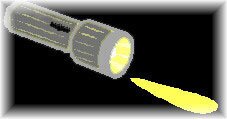 Dark Corners Menu |
 Pitzer Main Page |
 Dark Corners Menu |
 Pitzer Main Page |
This article will make most sense if The Case for Homicide is read first.
![]()
by Allan Eaglesham
| Lieutenant Commander William Bruce Pitzer died of a gunshot wound to the head on October 29, 1966, at the National Naval Medical Center, Bethesda, MD. Seven aspects of the evidence (discussed in an accompanying article in terms of homicide) are reconsidered in light of new information, notably the autopsy photographs and input from an officer of the Naval Criminal Investigative Service. Also revisited is LCDR Pitzer's purported possession of a movie film of the autopsy on President Kennedy's body. |
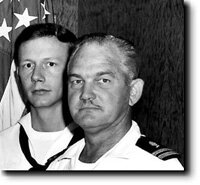 Harold Rydberg & William Pitzer (Courtesy of Harold Rydberg) |
|
WILLIAM PITZER WAS NOT LEFT-HANDED
Since LCDR Pitzer's colleague Dennis David and widow stated it unequivocally (according to author Harrison Livingston in High Treason 2 (Carroll & Graf, 1992) and in Stunning New Evidence in the JFK Case [http://www.harrison-e-livingstone.com/jfk/]), it appears certain that William Pitzer was left-handed. However, Mr. Livingstone failed to remind his readers that Mrs. Pitzer had already given him different information: High Treason (co-authored by Robert Groden, Conservatory Press, 1989) states, "His widow said...he was right-handed." In a telephone conversation with Daniel Marvin in 1995, of which I have an audiotape, Mrs. Pitzer stated clearly that her husband had been right-handed [4]: Marvin: Was he -- was Bill -- right-handed or left-handed? And documents released under the Freedom of Information Act (FOIA) in 1997 to Marvin by the FBI (who investigated Pitzer's death in conjunction with the Naval Investigative Service) confirmed that Pitzer was right-handed. Yet, in a 2003 interview for a television documentary shown in Russia, of which I also have a copy, Marvin stated that William Pitzer had been left-handed. Thus, despite information to the contrary from the best possible source -- the widow -- both Livingstone and Marvin appear to have a vested interest in perpetuating a myth. I have verified that he was right-handed with two other members of the Pitzer family and with navy colleague Alvin Edwards, himself left-handed, who witnessed LCDR Pitzer committing his signature to paper on many occasions. A sketch of the death scene made by NIS and FBI investigators shows an ashtray on the floor to the right of an empty chair (the other chair had a pad and pencil on it), a strong indication in itself that Pitzer was right-handed (Figure 1). 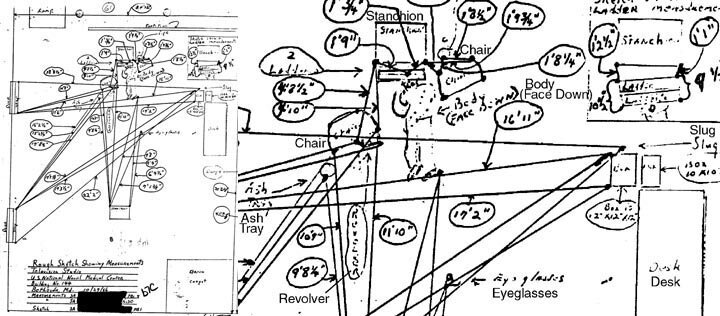
Figure 1. Investigators' sketch of the TV studio in which LCDR Pitzer's body was found.
It seemed possible that the opinion of forensic expert Herbert MacDonell that the death-scene photograph shows a bullet wound in LCDR Pitzer's left temple (see the Figures 2 and 3 in the accompanying article) would have a bearing on efforts to have the case reopened (described in [2,3]). I requested a meeting with Naval Criminal Investigative Service Special Agent DiPaola (Head of the Homicide Division, with whom I had been in contact before [3]) who kindly agreed to see me in his office at the National Naval Medical Center, Bethesda, MD. On the afternoon of April 3, 2002, he gave me three and a half hours of his time after driving from North Carolina to keep our appointment. |
|
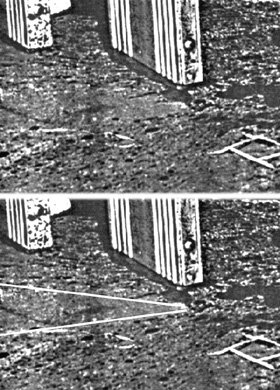
Figure 2. Ladder movement revealed by an area relatively free of blood spatter. |
SA DiPaola stated that Professor MacDonell was not justified in saying that the photograph shows a bullet wound in the left temple; it could be pooled blood from the exit wound above and slightly behind the ear. He again expressed the opinion that the available information is consistent with suicide and, absent autopsy photographs, everything else is open to interpretation. In his view, LCDR Pitzer was sitting when he shot himself. He slumped over to his left and the exit wound bled profusely onto the floor, causing the broad spatter of blood seen in the photograph. Presumably his chair was similar to the one visible in the background of the death-scene photograph -- a wooden captain's chair -- from which his body gradually slid. The chair was at an angle of approximately 45 degrees to the stepladder; having been slumped heavily to its left by the force of the bullet, the body eventually came to rest belly down between the two chairs (see the investigators' sketch, Figure 1). Initially the head came into contact with the bottom step of the ladder, then the ladder closed enough for the head to fall onto the floor partially below the step. [That the ladder moved is shown by a vee-shaped area relatively clear of blood spatter (Figure 2).] |
|
BREAKTHROUGH -- AUTOPSY PHOTOGRAPHS RELEASED: NO WOUND IN THE LEFT TEMPLE
In April of 2000, researcher Joseph Scovitch informed me that materials related to Pitzer's autopsy would likely be archived at the Armed Forces Institute of Pathology (AFIP). I passed this information along to Special Agent DiPaola of the Naval Criminal Investigative Service who later told me that his enquiry at the AFIP revealed no Pitzer-related information. However, in June of 2002, Robert Pitzer happened to mention that a document on his father provided by the navy had originated with the AFIP, which brought to mind Mr. Scovitch's information. What other material might be held there? Immediately we sent formal FOIA applications to the AFIP for the autopsy photographs via the Internet (AE on behalf of RP) and by conventional mail (RP). In August of 2002, Mr. Pitzer received approximately twenty color and black and white autopsy photographs. (More autopsy photographs were sent later to him, bringing the total to approximately fifty.) A month later, researcher Kenneth Hersh saw these twenty photographs [5]. Most, if not all, were reversed, as revealed by the wedding ring appearing to be on the right hand, whereas the deceased wore it on his left hand. The photographs showed the entry wound to the right temple and the exit wound above and slightly behind the left ear; they showed no wound in the left temple. In March of 2004, I saw about a dozen of the autopsy photographs, as good-quality color prints. I confirmed that there was no wound in the left temple (Figure 3). I had with me Vincent J.M. Di Maio's book Gunshot Wounds: Practical Aspects of Firearms, Ballistics, and Forensic Techniques (Elsevier, 1985); the wound in LCDR Pitzer's right temple was closely similar to a hard contact wound of the head from a .38 revolver (Figure 4A). 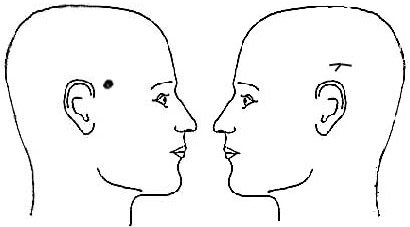 Figure 3. Approximate appearance and location of the wounds seen in the autopsy photographs.
Figure 4. Close-contact (A) and distant (B) wounds.
Petty Officer Harold Rydberg -- head of Medical Illustration and senior instructor for the School of Medical Illustration at the Naval Medical School from 1962 to 1968 -- informed me that none of the navy pathologists were fully qualified in forensics; they completed only a 1-month course [6]. Their experience of gunshot wounds would have been limited, at best, which may explain why Dr. John Ball, deputy medical examiner for Montgomery County, was brought in to examine the body at the scene. If the autopsy doctors had any experience of close revolver wounds, it is likely that they had experience also of deposits of soot, gunshot residue and/or powder tattooing in the vicinity of those wounds. I believe that they missed an important clue in this regard, which is present in the autopsy photographs: William Pitzer's left hand had a heavy deposit of soot on the palm and his right hand had a heavy deposit of soot on the backs of the fingers. This suggests that he held and fired the revolver with his right hand, and steadied it with his left hand held over the barrel. Soot and gunshot residue would thus be propelled into the wound or would be blocked by the palm of the left hand as it escaped from around the barrel, some of which would be deflected over the backs of the fingers of the right hand. The autopsy report states that microscope examination of sections from the margin of the entrance wound "reveal...prominent collections of a dark brown to black granular material presumably representing nitrates." This statement is indicative of lack of experience on the part of the autopsy doctors; nitrate is not coloured brown on black -- soot is -- and presence of nitrate in the wound would be indicative of a close-contact shot, at odds with other comments they made. It is noteworthy that an FBI interview report, dated 11/2/66 for Dr. Ball, stated: When he observed the wound in the head on the night of November [sic] 29, 1966, he observed muzzle marks around the wound and powder burns. I believe that the autopsy photographs show muzzle marks at the wound (again, very similar to what is seen in Figure 6A). Apart from charring around the wound, I did not see powder burns. In an earlier discussion of the wounds [2], I theorized that this description by Dr. Ball applied to a left-temple wound and was indicative of homicide. The autopsy photographs dispel this theory: there was no bullet wound at the left temple. The reversal of the autopsy prints offers an explanation as to why the navy medical examiner described a left-temple wound (see the accompanying article). For obscure reasons, his report is dated February 1, 1967, i.e. three months after the death. If the navy medical examiner used similar (reversed) photographs of the body to refresh his recollection in the preparation of his report, it is possible that he mistakenly described a left-temple wound. But what are we to make of "fracture, comminuted, supraorbital plate, sphenoid bone, left" as stated on the cover page of the autopsy protocol? In a section of his book, "Secondary Fractures of the Skull," Vincent Di Maio states [7]: As the bullet perforates the brain, it produces a temporary cavity that undergoes a series of pulsations before disappearing. The pressure waves in the brain in the case of high-velocity missiles may produce massive fragmentation of the skull. In the case of handgun bullets, the pressure waves are considerably less but still may cause fractures. Linear fractures of the orbital plates are the most common because of the paper-thin nature of the bone... These secondary fractures of the skull are seen most commonly with medium and large-caliber handguns... No matter what the caliber, secondary fractures are more common with contact wounds, where the pressure waves from the temporary cavity are augmented by pressure from the expanding gas. [emphasis added] Hence, we have an explanation for the location of the third defect in the skull bone and also for the absence of corresponding lesions in the overlying skin or underlying brain. In fact, the third defect is consistent with the right-temple wound being a close-contact shot.
Again, quoting directly from Vincent Di Maio's book [8]: In contrast to what is seen on television and read in mystery books, it is rare for an identifiable fingerprint to be left on a firearm, especially a handgun. Only a small surface area is suitable for leaving prints, and the recoil of the weapon causes the fingers to slide and produce smudges. Clearly, absence of LCDR Pitzer's fingerprints from the revolver is not evidence of homicide.
In discussing this aspect previously [1], I made the assumption that a dermal nitrate test was referred to in the FBI report; in the early 1960s, "paraffin test" and "dermal nitrate test" were synonymous. With closer inspection of the hand-written laboratory notes (Figure 5), I realized that I was in error. 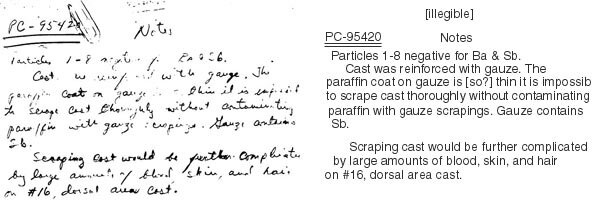 Figure 5. FBI laboratory report on the tests of the paraffin casts.
|
|
|
TRAJECTORY AND DENTED BLACKBOARD
Lee Andre, an enlisted man in LCDR Pitzer's command, told me [9] that he entered the TV studio early on the morning of Monday October 31, 1966, after reporting for duty. He found the area cleaned up, apart from what appeared to be a tooth on the floor. I provided Mr. Andre with a sketch of the studio, showing the stanchions, doors, desk, etc., and asked him to locate the movable blackboard, on the assumption that those who cleaned up the studio would likely have replaced it in a location close to where they had found it. Mr. Andre indicated three locations in which the blackboard was sometimes placed, but he showed that, on the Monday morning, it was standing close to where Pitzer's body had been found (Figure 6). Likewise the putative tooth was on the floor close to where the deceased had been sitting. |
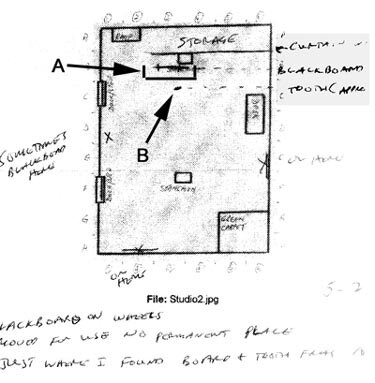 Figure 6. Locations of blackboard (A) and "tooth" (B) in the TV studio on the morning of 10/31/66. |
|
The investigators' doubts regarding the trajectory (see the accompanying article) may have arisen because they assumed that William Pitzer was standing facing the stepladders when the trigger was pulled. Blood-spatter pattern was not a routine component of forensic investigations in the 1960s. The pattern in Figure 2 indicates that blood fell from some height onto the floor for a period of time, a strong indication that the deceased was seated and thus facing away from the stepladders, not towards them. If, indeed, William Pitzer shot himself while seated, with the blackboard behind -- from which the bullet ricocheted -- it is plausible that the spent slug would come to rest where it did (Figure 1). It is possible, if not probable, that Mr. Andre mistook a sliver of skull bone for a tooth.
I recently learned from a member of the family, who learned it from Mrs. Pitzer herself, that she had asked a third member of the family to obtain the wedding ring. The third member of the family returned without the ring with the account that a contact person in the navy had stated that the left hand was damaged, preventing removal of the ring. In contrast, the autopsy report states: The upper and lower extremities...exhibit no remarkable gross lesions. No evidence of abrasions, contusions, or lacerations are noted in any part of the body with the exception of the head wounds. Likewise, neither Kenneth Hersh [5] nor I saw damage to either hand in the autopsy photographs (despite information to the contrary [10]). The third member of the family may have forgotten to request the wedding ring or decided that it should stay with the deceased, and invented the story of the mangled left hand.
In a recently published interview [11], Dennis David stated: Lieutenant Commander Barb Munroe...said, "[D]id you know Bill's dead?" And I said, "No, what happened?" Then she said, "Well, he shot himself." I said, "I don't believe that." And she said, "Well they found him with a gun in his right hand, and he blew his brains out." And I said, "But Bill's left-handed..." That was the first time I had heard he was dead. I asked, "Well, why did he commit suicide?" And she said "It's highly questionable that he did." I said, "Well, it stands to reason." And then she said something to me about, "Did you know that he'd had some pretty good job offers?" And I said I had, and that just before the last time I'd seen him, just before I'd left Bethesda, he'd told me that he had some very lucrative offers from a couple of the national networks like ABC, CBS, to go to work for them. I said, "I suspect it was probably because of some of the films and the material he had from the assassination." She said, "You know he had those?" And I said, "Yes, because I was over there a couple, three days after the autopsy and saw them." She kind of nodded her head as though she agreed with me, or something like that. [emphasis added] In August of 2002, I attempted to contact Commander Munroe/Munro/Monroe via the Retired Naval Personnel Navy Locator service in St. Louis. Shortly after, I received a telephone call from a lady at the Navy Personnel Command, Millington, TN. She informed me that "Munroe" was the correct spelling, and that two women were potentially applicable, one in her fifties and one in her eighties. Clearly, the lady in her eighties was the one I sought. In early September, I received a form letter from Millington stating, "Your letter has been forwarded to the service member: CDR Barbara Munroe (Retired)." On September 16, 2002, I e-mailed Dennis David: Almost three weeks have passed since the Navy Locator Service sent my letter on to Commander Munroe. I have heard nothing from her, I am sorry to say. On January 20, 2003, I followed up with a similar e-mail message to Mr. David, suggesting again that he make contact with CDR Munroe; as far as I know, he did not follow through. In June 2003, he e-mailed me the telephone number of Ruth Moeller in Bethesda, MD, as a possible link with William Pitzer. A few days later I spoke with Captain Moeller. She did not recall William Pitzer or Dennis David, but she had known Barbara Munroe well; CDR Munroe had died about a year before.
By invitation of a family member, I participated in a search of the Pitzer residence in suburban Washington, DC (Figure 7A), during the weekend of November 13-14, 2004. Apart from a few items of furniture in the basement family room (Figure 7B), the house was empty. 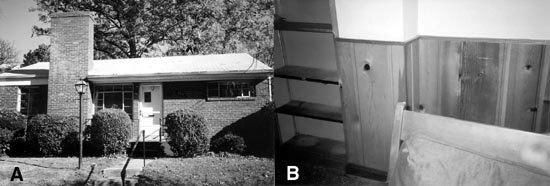 Figure 7. The Pitzer residence. |
|
 Figure 8. Location of a movie-film spool. |
Nothing of significance was found. However, to make a thorough search would have meant causing significant damage to the family-room ceiling and wall paneling (Figure 7B), which William Pitzer had personally installed.
It is noteworthy that, approximately three weeks before my visit, an empty movie spool had been discovered above ceiling tiles in the kitchen (Figure 8). A prospective buyer of the property noticed evidence of dampness on the kitchen ceiling and asked as to its origin. When a tile was pushed upwards for inspection, a 5-inch chocolate-colored metal spool became visible. It was for 8-mm film. |
|
As intriguing as this discovery is, I feel it would be a mistake to ascribe great significance to it. Eight-mm film was the medium for home movies before it was supplanted by video in the 1990s; it was not used professionally. A movie spool that originated at the National Naval Medical Center would have been for 16-mm film. Most probably, this item was placed in a location in which it was likely to be discovered -- as a joke or with the intention to mislead.
I have not been given any of the autopsy photographs, therefore I've been unable to have them examined by forensic experts. In this complex subject matter, lay opinion carries little weight. Although my previous attempts under FOIA to obtain copies of the autopsy photographs had failed because of lack familial ties, I made another attempt in May, 2004: "To lay this matter to rest to the degree possible, these photographs must be examined by forensic experts and their professional opinions made public." In late June, 2004, I received a denial of this request, which I appealed shortly thereafter: The purpose of this letter is to request that you reconsider this decision on the grounds that public interest aspects -- summarized in my original request but not responded to -- outweigh privacy considerations under FOIA exemptions 6 and 7(C). You did not elucidate what the privacy claim is based on: who will suffer and what kind of injury. I am grateful to James Lesar for his suggestions on wording the original request and the appeal. In early November, 2004, this response arrived from the Office of the General Council in the Department of the Army: After a careful review of the issues presented in your appeal, we have determined that the information you requested was properly withheld... Accordingly your appeal is denied... You may, if you so desire, seek judicial review of this determination in the federal court system... Unless a member of the Pitzer family makes the autopsy photographs available for expert scrutiny or a FOIA lawyer "takes up the cudgels" on a pro bono basis, the significance of the autopsy photographs will be cause for debate.
|
|
 Dark Corners Menu |
 Pitzer Main Page |
